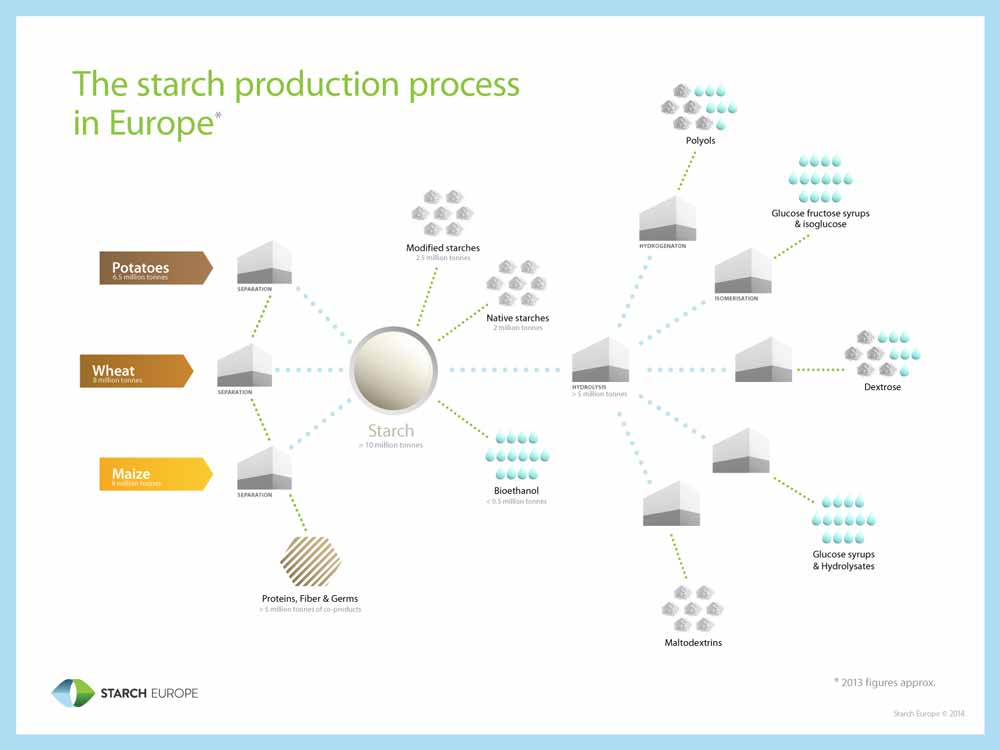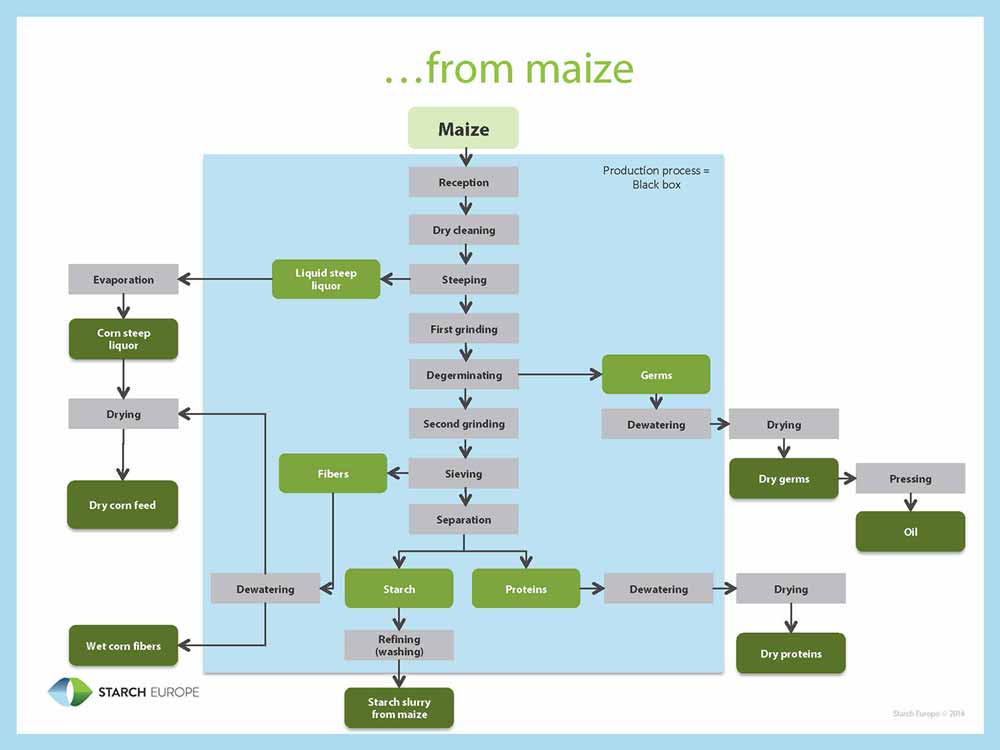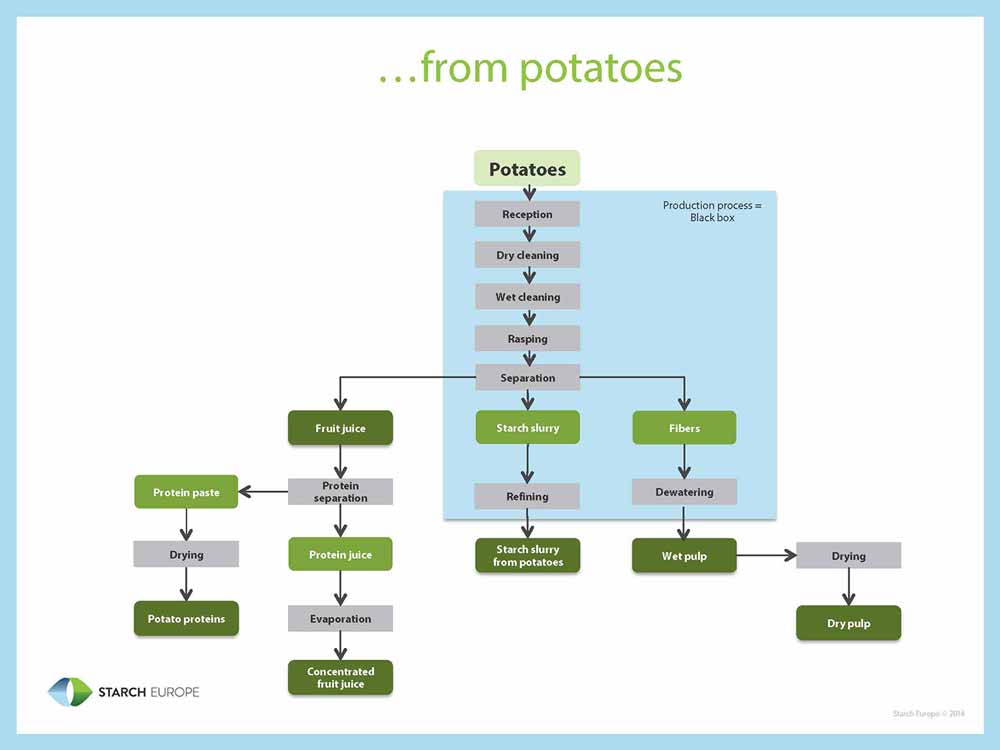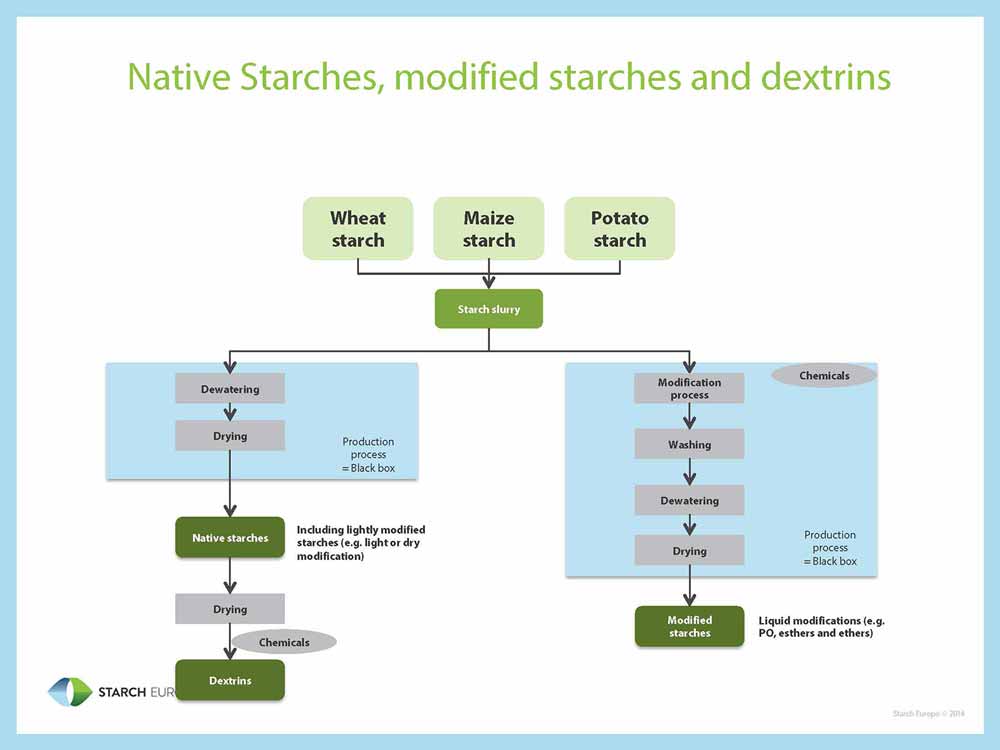Starch extraction and processing: from plant to powder.
Starch is the glucide reserve of plants. In Europe it is found in maize, wheat and potato from which it is extracted, as well as in many other plants: rice, barley, vegetables, manioc, sweet potato.
The formation of starch in plants is through the process of photosynthesis. This physiological mechanism makes it possible for the plants to produce and store the glucose (elementary sugar) which is necessary for their growth and reproduction.
Initially, the plant assimilates the carbon from the atmosphere and transforms it into glucose, the basic molecule. This is then used for the synthesis of the starch polymers associated with pure glucose.
Initially, the plant assimilates the carbon from the atmosphere and transforms it into glucose, the basic molecule. This is then used for the synthesis of the starch polymers associated with pure glucose.
Like the image of a “pearl necklace”, each plant organises and structures its macromolecules of glucose in a different way, the number of glucose units which can vary from 100 to 20,000 in each polymer. In plants, starch appears as small granules, insoluble in cold water, the size (between 3 and 100 microns) and form vary according to the origin.
The starch industry separates the components of the plant: starch, protein, cellulose envelope, soluble fractions and in the case of maize, the germ from which oil will be extracted. This first phase utilises a series of simple stages of physical separation of the components: crushing, sifting, centrifuging, etc… However the methods of manufacture are specific to each plant and the industrial tools are normally dedicated to a raw material (maize, wheat or potato in Europe). In the second stage, the starch which has been extracted in its purest form, will be used as it is after drying (this is called “native starch”) or it will be further processed, undergoing various transformations aiming either at modifying its performance (“modified starch”) or to obtain sweeteners through the process of hydrolisis.
The starch industry separates the components of the plant: starch, protein, cellulose envelope, soluble fractions and in the case of maize, the germ from which oil will be extracted. This first phase utilises a series of simple stages of physical separation of the components: crushing, sifting, centrifuging, etc… However the methods of manufacture are specific to each plant and the industrial tools are normally dedicated to a raw material (maize, wheat or potato in Europe). In the second stage, the starch which has been extracted in its purest form, will be used as it is after drying (this is called “native starch”) or it will be further processed, undergoing various transformations aiming either at modifying its performance (“modified starch”) or to obtain sweeteners through the process of hydrolisis.
At the end of the process the starch and derived products are delivered to customer industries in the form of powder (with an appearance similar to that of flour) or of syrups.
What is starch?
Starch is a carbohydrate extracted from agricultural raw materials which is widely present in literally thousands of everyday food and non-food applications. It is the most important carbohydrate in the human diet. Because it is renewable and biodegradable it is also a perfect raw material as a substitute for fossil-fuel components in numerous chemical applications such as plastics, detergents, glues etc. For more on the food, feed and industrial uses click here. The starch molecule consists of a large number of glucose units joined by glycosidic bonds. It is produced by all vegetables as an energy store. In Europe it is extracted almost exclusively from potatoes, wheat and maize.
Native Starch
Once extracted, pure starch (native starch) is a white tasteless and odourless powder that is insoluble in cold water or alcohol, which is used widely in the food and paper industry primarily for binding and thickening purposes
Modified starches
Pure starch can then be modified by a chemical, physical or enzymatic process to create ‘modified starches’, each offering differing characteristics and used widely in the food, paper, textile, oil, adhesives, fermentation and pharmaceutical industries.
The properties of starches are well-known, however knowledge continues to progress in the understanding of the physicochemical bases of their application.To bind, thicken, texture, stabilise and gel are some of the traditional functions of starch. Native starches are perfectly suited to a wide variety of applications, food or non-food, where their properties remain irreplaceable. Very early however, it appeared necessary, in some cases, to improve the performance of the starch and to respond to the needs of customers, giving other improved functionality or behaviour: solubility with cold water, more stable viscosity with the variations of temperature, hot fluidity, better stability…
The first modified starch dates from the 19th century and other modified starches were since then developed, often in partnership with customer industries, which sought to make starches compatible with their industrial processes. In the food area, the principal modifications aim at adapting the starch to the technological constraints resulting for example from cooking, freezing/thawing, canning or sterilisation and to make them compatible with a modern food (microwavable, instant preparations, ultra high temperatures and so on). One of the objectives common to the majority of these transformations is to limit the natural tendency of starch to be retrogress. During the cooking of soup for example, the native starch is hydrated in contact with water. The starch granules expand and the “viscosity” of the solution increases giving it a particular texture. The various modifications of starch make it possible to obtain:
• easier food preparation
• better conservation of food
• better stability of food even when heated under severe conditions (preserves for example, to ensure their sterility)
• easier food preparation
• better conservation of food
• better stability of food even when heated under severe conditions (preserves for example, to ensure their sterility)
Main technical modifications:
”Cross Linking is the creation of bridges between the starch chains with specific connections. This process makes it possible to maintain inflated granules and to decrease the loss of viscosity.; Substitution gives stabilisation property to starch, mainly during cycles of freezing and thawing. This is thanks to molecules which ensure the repulsion between the starch chains, these cannot recombine. The minimisation of the starch retrogradation is thus ensured.”
”Cross Linking is the creation of bridges between the starch chains with specific connections. This process makes it possible to maintain inflated granules and to decrease the loss of viscosity.; Substitution gives stabilisation property to starch, mainly during cycles of freezing and thawing. This is thanks to molecules which ensure the repulsion between the starch chains, these cannot recombine. The minimisation of the starch retrogradation is thus ensured.”
Source: https://starch.eu/starch/





